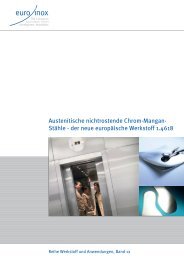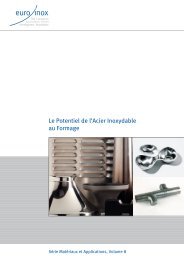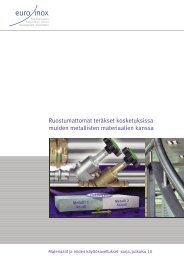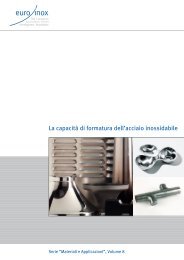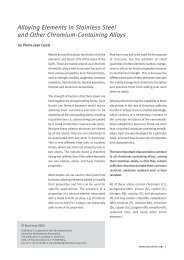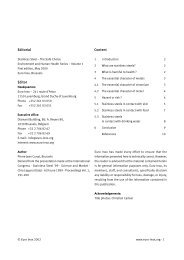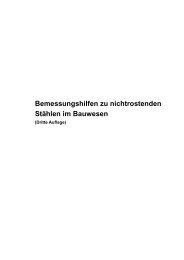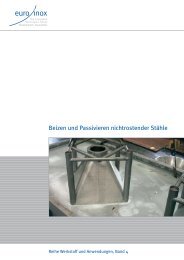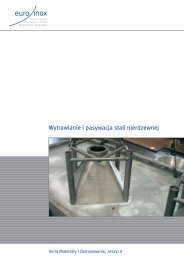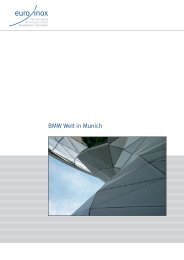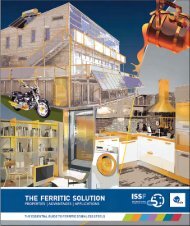Innovative Stainless Steel Applications in transport ... - Euro Inox
Innovative Stainless Steel Applications in transport ... - Euro Inox
Innovative Stainless Steel Applications in transport ... - Euro Inox
Create successful ePaper yourself
Turn your PDF publications into a flip-book with our unique Google optimized e-Paper software.
• Tungsten <strong>in</strong>ert gas weld<strong>in</strong>g (TIG)<br />
• Plasma arc weld<strong>in</strong>g (PAW)<br />
Shielded metal arc weld<strong>in</strong>g (SMAW, “stick weld<strong>in</strong>g”)<br />
Shielded metal arc (SMAW), also called manual metal arc weld<strong>in</strong>g (MMAW), is an arc<br />
weld<strong>in</strong>g process that uses a consumable shielded electrode, up to approximately<br />
400 mm <strong>in</strong> length, as the filler material. The arc is formed between the electrode and the<br />
workpiece. The core wire of the electrode melts and molten metal transfers <strong>in</strong>to the<br />
weld pool through the arc <strong>in</strong> droplets, which are shielded from oxidation by the gases<br />
and slag formed from the electrode coat<strong>in</strong>g. Eventually, the slag solidifies on top of the<br />
weld bead, where it cont<strong>in</strong>ues to protect the solidified weld metal. It is removed after<br />
weld<strong>in</strong>g. The ma<strong>in</strong> disadvantages of SMAW are the use of a non-cont<strong>in</strong>uous electrode<br />
and the formation of slag that has to be removed. As a consequence of the former, the<br />
technique is non-automated and requires skilled welders. Today, SMAW has been<br />
mostly superseded <strong>in</strong> production by more productive methods, such as MIG/MAG, but<br />
it still plays an important role <strong>in</strong> on-site <strong>in</strong>stallation and repair work.<br />
Metal <strong>in</strong>ert or active gas weld<strong>in</strong>g (MIG/MAG) and variants<br />
In MIG/MAG or gas metal arc weld<strong>in</strong>g (GMAW), the arc is formed between a<br />
cont<strong>in</strong>uous, consumable filler-metal wire and the workpiece. A wire feed unit delivers<br />
th<strong>in</strong> (typically ø 0.8 to 1.2 mm) filler metal wire through the weld<strong>in</strong>g torch <strong>in</strong>to the arc.<br />
The molten metal is transferred either by dipp<strong>in</strong>g <strong>in</strong>to the weld pool or through a spray<br />
of coarse or f<strong>in</strong>e droplets. The shield<strong>in</strong>g gas may be either <strong>in</strong>ert (pure argon) or active<br />
(an argon and carbon dioxide mixture). Carbon steel weld<strong>in</strong>g is almost always MAG<br />
(us<strong>in</strong>g active gas). MIG (us<strong>in</strong>g <strong>in</strong>ert gas) is usually used for non-ferrous metals.“MIG<br />
weld<strong>in</strong>g”, however, is often employed as a general term cover<strong>in</strong>g both variants. A multipurpose<br />
weld<strong>in</strong>g hose supplies the wire, weld<strong>in</strong>g current, shield<strong>in</strong>g gas, control power<br />
and (<strong>in</strong> some cases) cool<strong>in</strong>g water – <strong>in</strong> their own conductors, cables and hoses – to the<br />
torch.<br />
With the <strong>in</strong>troduction of <strong>in</strong>creas<strong>in</strong>gly high-strength C-Mn and sta<strong>in</strong>less steel grades,<br />
new developments <strong>in</strong> MIG/MAG-based weld<strong>in</strong>g techniques have emerged. The high<br />
material strength achieved, at least partially, by complex thermo-mechanical treatments,<br />
is easily dim<strong>in</strong>ished by the heat <strong>in</strong>put of arc weld<strong>in</strong>g processes. The consequent need to<br />
control and decrease heat <strong>in</strong>put has led to more sophisticated power-source<br />
technologies, such as digital weld<strong>in</strong>g current control and even wire-feed puls<strong>in</strong>g<br />
techniques. Another approach is to use lower-melt<strong>in</strong>g filler metals (usually various<br />
copper-based alloys, such as silicon or alum<strong>in</strong>ium bronzes), <strong>in</strong> which case not fusion<br />
weld<strong>in</strong>g but braz<strong>in</strong>g or braze-weld<strong>in</strong>g is performed, us<strong>in</strong>g MIG/MAG equipment.<br />
83



